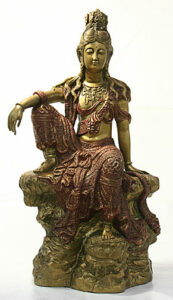Acupoints Target the Hypothalamus Pituitary Axis
Kristen Sparrow • December 19, 2015

This study explores

Goddess of Compassion
“She who hears the cries of the world”
which acupuncture points might best modulate the hypothalamus/pituitary axis. This information correlates directly with my HRV work since the stress response is associated with the HPAA. So this will be pretty fun to evaluate the HRV response to the points that they determined to be the most active eg Shenshu (BL23), Ganshu (BL18), Qimen (LR14), Jingmen (GB25), Riyue (GB24), Zangmen (LR13), Dazui (DU14) and auricular concha region (ACR).
These points are different from ones I usually use for nervous system balancing, so maybe I’ve been missing an important piece. A Swiss doctor I met at the Society for Acupuncture Research meeting told me he uses triangular needle blood letting at 43V for patients with panic and gets great results. I’m wondering if he is activating innervation to the adrenals even though higher up.
Acupoint specificity on acupuncture regulation of hypothalamic- pituitary-adrenal cortex axis function.
The hypothalamus is an essential part of the brain that responds to a variety of signaling including stressful stimulations and acupuncture signals. It is also the key element of the hypothalamic-pituitary-adrenal cortex axis(HPAA). The effect of acupuncture is transmitted into the brain from the distance sensory receptor around the acupoints via peripheral nerves and body fluid. In vivo recording the activities of stress reaction neurons (SRNs, CRH-like neurons) in hypothalamic paraventricular nucleus (PVN) in response to the stimulations from different acupoints could therefore objectively reflect the acupuncture afferent effect.
METHODS:
In this study, the electrophysiological method was adopted to record synchronously the activities of 43 CRH-like neurons after acupuncture stimulations at 33 acupoints located at the different regions. The acupoints that specifically activate certain CRH-like neurons (specificity acupoints) were selected. Furthermore, we investigated in a rat model of unpredictable chronic mild stress (UCMS) whether these specificity acupoints regulate HPAA function. The endpoints of measurement include corticosterone (CORT) level in peripheral blood, the expressions of corticotrophin releasing hormone (CRH) and glucocorticoid receptor (GR) protein in PVN and the animal behavioral performance.
RESULTS:
Our results reveal that Shenshu (BL23), Ganshu (BL18), Qimen (LR14), Jingmen (GB25), Riyue (GB24), Zangmen (LR13), Dazui (DU14) and auricular concha region (ACR) are the specificity acupoints; and Gallbladder, Liver and Du Channels were the specificity Channels. The acupoints on Gallbladder Channel and the acupoints innervated by the same spinal cord segments as the adrenal gland demonstrated dramatic effects
http://www.ncbi.nlm.nih.gov/pubmed/25887143

